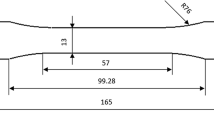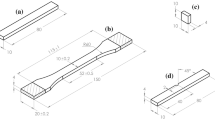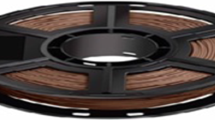Abstract
This paper aims to determine the flexural stiffness and strength of a composite made of a polylactic acid reinforced with wood particles, named commercially as Timberfill, manufactured through fused filament fabrication (FFF). The influence of four factors (layer height, nozzle diameter, fill density, and printing velocity) is studied through an L27Taguchi orthogonal array. The response variables used as output results for an analysis of variance are obtained from a set of four-point bending tests. Results show that the layer height is the most influential parameter on flexural strength, followed by nozzle diameter and infill density, whereas the printing velocity has no significant influence. Ultimately, an optimal parameter set that maximizes the material’s flexural strength is found by combining a 0.2-mm layer height, 0.7-mm nozzle diameter, 75% fill density, and 35-mm/s velocity. The highest flexural resistance achieved experimentally is 47.26 MPa. The statistical results are supported with microscopic photographs of fracture sections, and validated by comparing them with previous studies performed on non-reinforced PLA material, proving that the introduction of wood fibers in PLA matrix reduces the resistance of raw PLA by hindering the cohesion between filaments and generating voids inside it. Lastly, five solid Timberfill specimens manufactured by injection molding were also tested to compare their strength with the additive manufactured samples. Results prove that treating the wood-PLA through additive manufacturing results in an improvement of its resistance and elastic properties, being the Young’s module almost 25% lower than the injected material.












Similar content being viewed by others
Data availability
The raw/processed data required to reproduce these findings cannot be shared at this time as the data also forms part of an ongoing study.
Abbreviations
- AM:
-
Additive manufacturing
- FFF:
-
Fused filament fabrication
- DOE:
-
Design of experiments
- ANOVA:
-
Analysis of variance
References
Chia HN, Wu BM (2015) Recent advances in 3D printing of biomaterials. J Biol Eng 9(1):4
Brenken B, Barocio E, Favaloro A, Kunc V, Pipes RB (2018) Fused filament fabrication of fiber-reinforced polymers. A review. Addit Manuf 21:1–16
Cuan-Urquizo E, Barocio E, Tejada-Ortigoza V, Pipes RB, Rodriguez CA, Roman-Flores A (2019) Characterization of the mechanical properties of FFF structures and materials. A review on the experimental, computational and theoretical approaches. Materials (Basel) 12(6)
Jerez-Mesa R, Travieso-Rodriguez JA, Lluma-Fuentes J, Gomez-Gras G, Puig D (2017) Fatigue lifespan study of PLA parts obtained by additive manufacturing. Procedia Manuf 13:872–879
Afrose MF, Masood SH, Lovenitt P, Nikzad M, Sbarski I (2015) Effects of part build orientations on fatigue behaviour of FDM-processed PLA material. Progress Addit Manuf 1(1–2):21–28
Gomez-Gras G, Jerez-Mesa R, Travieso-Rodriguez JA, Lluma-Fuentes J (2018) Fatigue performance of fused filament fabrication PLA specimens. Mater Des 140:278–285
Es-Said OS, Foyos J, Noorani R, Mendelson M, Marloth R, Pregger BA (2000) Effect of layer orientation on mechanical properties of rapid prototyped samples. Mater Manuf Process 15:107–122
Wu W, Geng P, Li G, Zhao D, Zhang H, Zhao J (2015) Influence of layer thickness and raster angle on the mechanical properties of 3D-printed PEEK and a comparative mechanical study between PEEK and ABS. Materials (Basel) 8(9):5834–5846
Shabat D, Rosenthal Y, Ashkenazi D, Stern A (2017) Mechanical and structural characteristics of fused deposition modeling ABS material. Annals of “Dunarea de Jos” University, Fascicle XII, Welding Equipment and Technology 28:16–24
Sood AK, Ohdar RK, Mahapatra SS (2010) Parametric appraisal of mechanical property of fused deposition modelling processed parts. Mater Des 31:287–295
Araya-Calvo M, López-Gómez I, Chamberlain-Simon N, León-Salazar JL, Guillén-Girón T, Corrales-Cordero JS (2018) Evaluation of compressive and flexural properties of continuous fiber fabrication additive manufacturing technology. Addit Manuf 22:157–164
El Margi A, El Mabrouk K, Vaudreui S, Ebn Touhami M (2019) Mechanical properties of CF-reinforced PLA parts manufactured by fused deposition modeling. J Thermoplast Compos Mater p. 0892705719847244
Jo MY, Ryu YJ, Ko JH, Yoon JS (2012) Effects of compatibilizers on the mechanical properties of ABS/PLA composites. J Appl Polym Sci 125(S2):E231–E238
Rosenzweig DH, Carelli E, Steffen T, Jarzem P, Haglund L (2015) 3D-printed ABS and PLA scaffolds for cartilage and nucleus pulposus tissue regeneration. Int J Mol Sci 16(7):15118–15135
Cantrell JT, Rohde S, Damiani D, Gurnani R, DiSandro L, Anton J, Young A, Jerez A, Steinbach D, Kroese C, Ifju PG (2017) Experimental characterization of the mechanical properties of 3D-printed ABS and polycarbonate parts. Rapid Prototyp J 23(4):811–824
Tymrak BM, Kreiger M, Pearce JM (2014) Mechanical properties of components fabricated with open-source 3-D printers under realistic environmental conditions. Mater Des 58:242–246
Bagheri A, Buj-Corral I, Ferrer M, Pastor MM, Roure F (2018) Determination of the elasticity modulus of 3D-printed octet-truss structures for use in porous prosthesis implants. Materials 11(12):2420
Ozcelik B, Ozbay A, Demirbas E (2010) Influence of injection parameters and mold materials on mechanical properties of ABS in plastic injection molding. Int Commun Heat Mass Transfer 37(9):1359–1365
Casavola C, Cazzato A, Moramarco V, Pappalettere C (2016) Orthotropic mechanical properties of fused deposition modelling parts described by classical laminate theory. Mater Des 90:453–458
Quintana R, Choi JW, Puebla K, Wicker R (2009) Effects of build orientation on tensile strength for stereolithography-manufactured ASTM D-638 type I specimens. Int J Adv Manuf Technol 46(1–4):201–215
Galantucci LM, Lavecchia F, Percoco G (2010) Quantitative analysis of a chemical treatment to reduce roughness of parts fabricated using fused deposition modeling. CIRP Ann 59:247–250
Maidin S, Mohamed AS, Akmal S, Mohamed SB, Wong JHU (2018) Feasibility study of vacuum technology integrated fused deposition modeling to reduce staircase effect. Journal of Fundamental and Applied Sciences 10(1S):633–645
Lederle F, Meyer F, Brunotte GP, Kaldun C, Hübner EG (2016) Improved mechanical properties of 3D-printed parts by fused deposition modeling processed under the exclusion of oxygen. Progress Addit Manuf 1(1-2):3–7
Malinauskas M, Rekštytė S, Lukoševičius L, Butkus S, Balčiūnas E, Pečiukaitytė M, Baltriukienė B, Bukelskienė V, Butkevičius A, Kucevičius P, Rutkūnas V, Juodkazis S (2014) 3D microporous scaffolds manufactured via combination of fused filament fabrication and direct laser writing ablation. Micromachines 5(4):839–858
Abedini A, Asiyabi T, Campbell HR, Hasanzadeh R, Azdast T (2019) On fabrication and characteristics of injection molded ABS/Al2O3 nanocomposites. Int J Adv Manuf Technol 102(5–8):1747–1758
Nejad SJ, Hasanzadeh R, Doniavi A, Modanloo V (2017) Finite element simulation analysis of laminated sheets in deep drawing process using response surface method. Int J Adv Manuf Technol 93(9–12):3245–3259
De Ciurana J, Serenóa L, Vallès È (2013) Selecting process parameters in RepRap additive manufacturing system for PLA scaffolds manufacture. Procedia CIRP 5:152–157
Testing A.S.f. and Materials. Standard test method for flexural properties of unreinforced and reinforced plastics and electrical insulating materials by four-point bending. (2002) ASTM International
Mohamed OA, Masood SH, Bhowmik JL (2015) Optimization of fused deposition modeling process parameters a review of current research and future prospects. Adv Manuf 3:42–53
Travieso-Rodriguez JA, Jerez-Mesa R, Llumà J, Traver-Ramos O, Gomez-Gras G, Roa Rovira JJ (2019) Mechanical properties of 3D-printing polylactic acid parts subjected to bending stress and fatigue testing. Materials 12(23):3859
Funding
J.J. Roa acknowledges the Serra Húnter programme of the Generalitat de Catalunya for the financial support.
Author information
Authors and Affiliations
Corresponding author
Additional information
Publisher’s note
Springer Nature remains neutral with regard to jurisdictional claims in published maps and institutional affiliations.
Rights and permissions
About this article
Cite this article
Zandi, M.D., Jerez-Mesa, R., Lluma-Fuentes, J. et al. Experimental analysis of manufacturing parameters’ effect on the flexural properties of wood-PLA composite parts built through FFF. Int J Adv Manuf Technol 106, 3985–3998 (2020). https://doi.org/10.1007/s00170-019-04907-4
Received:
Accepted:
Published:
Issue Date:
DOI: https://doi.org/10.1007/s00170-019-04907-4




